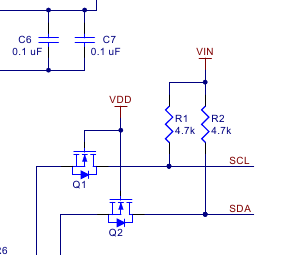Using the AltIMU-10
Connections
A minimum of four connections are necessary to use the AltIMU-10: VIN, GND, SCL, and SDA. VIN should be connected to a 2.5 V to 5.5 V source, GND to 0 volts, and SCL and SDA should be connected to an I²C bus operating at the same logic level as VIN. (Alternatively, if you are using the board with a 3.3 V system, you can leave VIN disconnected and bypass the built-in regulator by connecting 3.3 V directly to VDD.)
Pinout
PIN Description
SCL Level-shifted I²C clock line: HIGH is VIN, LOW is 0 V
SDA Level-shifted I²C data line: HIGH is VIN, LOW is 0 V
GND The ground (0 V) connection for your power supply. Your I²C control source must also share a common ground with this board.
VIN This is the main 2.5 V to 5.5 V power supply connection. The SCL and SDA level shifters pull the I²C bus high bits up to this level.
VDD 3.3 V regulator output or low-voltage logic power supply, depending on VIN. When VIN is supplied and greater than 3.3 V, VDD is a regulated 3.3 V output that can supply up to approximately 150 mA to external components. Alternatively, when interfacing with a 2.5 V to 3.3 V system, VIN can be left disconnected and power can be supplied directly to VDD. Never supply voltage to VDD when VIN is connected, and never supply more than 3.6 V to VDD.
The data ready and interrupt pins of the LPS331AP, L3GD20, and LSM303DLHC are not accessible on the AltIMU-10; if you need these outputs, consider using our LPS331AP carrier, L3GD20 carrier, and LSM303DLHC carrier boards.
The above schematic shows the additional components the carrier board incorporates to make the LPS331AP, L3GD20, and LSM303DLHC easier to use, including the voltage regulator that allows the board to be powered from a single 2.5 V to 5.5 V supply and the level-shifter circuit that allows for I²C communication at the same logic voltage level as VIN. This schematic is also available as a downloadable pdf: AltIMU-10 schematic (193k pdf).
I²C Communication
The LPS331AP’s barometer, the L3GD20’s gyro, and the LSM303DLHC’s accelerometer and magnetometer can be queried and configured through the I²C bus. Each of the four sensors acts as a slave device on the same I²C bus (i.e. their clock and data lines are tied together to ease communication). Additionally, level shifters on the I²C clock (SCL) and data lines (SDA) enable I²C communication with microcontrollers operating at the same voltage as VIN (2.5 V to 5.5 V). A detailed explanation of the protocols used by each device can be found in the LPS331AP datasheet (453k pdf), the L3GD20 datasheet (2MB pdf), and the LSM303DLHC datasheet (629k pdf). More detailed information about I²C in general can be found in NXP’s I²C-bus specification (371k pdf).
The barometer, gyro, accelerometer, and magnetometer each have separate slave addresses on the I²C bus. The board pulls the SA0 pins on the gyro and barometer high.
In our tests of the AltIMU-10, we were able to communicate with all three chips at clock frequencies up to 400 kHz; higher frequencies might work but were not tested. The chips themselves and carrier board do not meet some of the requirements to make the devices compliant with I²C fast mode. They are missing 50 ns spike suppression on the clock and data lines, and additional pull-ups on the clock and data lines might also be necessary to achieve compliant signal timing characteristics.


